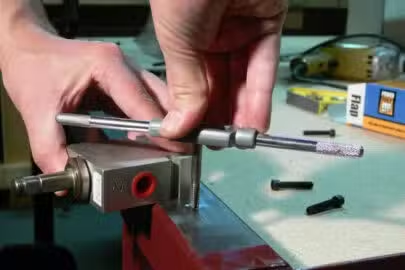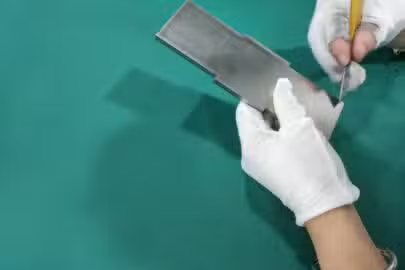Wire Electrical Discharge Machining (Wire EDM) is an important technology. It gives near-perfect accuracy and usefulness beyond comparison. It produces some incredibly precise parts with incredibly tight fits and dimensions by carefully controlling the vaporisation of metal using electrical discharge.This machining process is widely used by makers of parts in various industries and comes highly recommended in CNC machining shops. This article will cover wire EDM cutting, materials that work with it, and its applications in various industries.
EDM Cutting Process
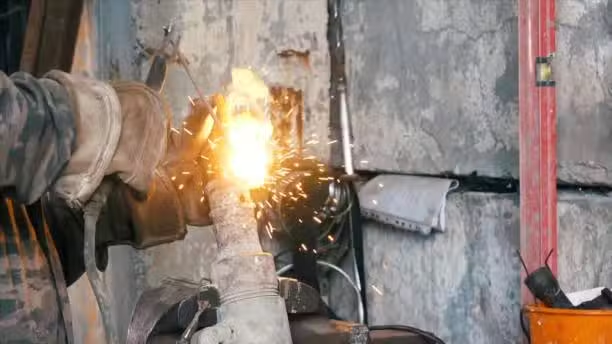
The wire EDM cutting process involves several key steps, including setup, flushing and die sinking, spark erosion, and wire path and guidance system. Here is a detailed explanation of the EDM cutting process:
Setup
The setup of an EDM machine is crucial for achieving accurate and precise results. It involves the following steps:
- Workpiece Preparation: The workpiece, often made of conductive materials like metals, is prepared according to the desired dimensions and shape. It is essential to ensure that the workpiece is securely clamped to the machine to prevent movement during the EDM process.
- Tool Electrode Selection: The tool electrode, typically made of a conductive material like copper or graphite, is chosen based on the specific material and intricacy of the workpiece. The tool electrode is the negative electrode in the EDM process.
- Dielectric Fluid Selection: A dielectric fluid, usually a specialized EDM oil, is used to facilitate the electrical discharge and to cool the workpiece and tool electrode. The dielectric fluid also helps flush the removed material from the cutting zone.
- Setting Parameters: Parameters such as current, voltage, pulse duration, and gap distance are set based on the material properties of the workpiece and tool electrode. These parameters determine the intensity and time of the electrical discharges.
Flushing and Die Sinking
This step involves the continuous dielectric fluid supply to the gap between the tool electrode and the workpiece. The dielectric fluid serves multiple purposes: it acts as a coolant, removes debris from the cutting zone, and helps conduct electrical discharges.
In die-sinking EDM, the tool electrode is gradually brought closer to the workpiece. This controlled approach is crucial for maintaining a consistent spark gap distance and ensuring a uniform material removal rate.
Spark Erosion
Once the setup is complete and the dielectric fluid flows, the EDM machine begins the spark erosion. This is the heart of the EDM cutting process. It involves generating a series of controlled electrical discharges between the workpiece and tool electrode.
- Electrical Discharge: When a high-frequency electrical pulse is applied, a spark or electrical discharge occurs between the tool electrode and the workpiece. This generates extremely high temperatures, causing localized melting and vaporization of the material.
- Material Removal: The intense heat of the electrical discharge causes small particles of the workpiece material to be removed, resulting in the desired shape. The dielectric fluid helps to flush away these particles, preventing them from accumulating and affecting the process.
Wire Path and Guidance System
In wire EDM, a thin, electrically conductive wire is used as the tool electrode. This wire is guided along a programmed path to create intricate shapes. The wire path and guidance system are critical components of the EDM machine.
- Wire Tensioning: The wire is tightly strung between two spools and kept under constant tension to ensure accurate and consistent cutting.
- Guidance System: The EDM machine is equipped with a sophisticated guidance system that precisely controls the movement of the wire along the programmed path. This system ensures the wire accurately follows the desired shape, allowing for intricate and complex cuts.
- Automatic Wire Threading: Modern EDM machines often have automatic wire threading systems that facilitate the wire threading through the workpiece.
EDM Applications

Production Applications
Here are the production applications of EDM:
- Mold Making: EDM is extensively used in the production of molds for various industries, including automotive, aerospace, and consumer goods. It allows for the creation of complex and highly precise mold cavities that are difficult to achieve through conventional machining methods.
- Die Making: EDM is crucial in producing dies used in processes like metal stamping, forging, and extrusion. It enables the creation of dies with intricate features and tight tolerances, ensuring high-quality and accurate production of parts.
- Punch and Die Manufacturing: Punches and dies are essential tools in operations like metal punching and blanking. EDM is employed to create these components with high precision. The accuracy of punches and dies is paramount for achieving consistent and defect-free results in punching operations.
- Extrusion Tooling : EDM is used to produce extrusion dies, which are critical in shaping materials like metals and plastics into desired profiles. It allows for creating complex extrusion profiles with fine details and tight tolerances, ensuring uniform product quality.
- Injection Mold Making: EDM plays a key role in the manufacturing of injection molds, which are used in processes like plastic injection molding. It enables the creation of intricate mold cavities with precise features, ensuring the production of high-quality molded parts.
- Tool and Die Repair and Modification: EDM is employed in the repair and modification of damaged or worn-out tools and dies, extending their lifespan and improving their performance. It allows for the restoration of critical components, reducing the need for complete replacements and minimizing downtime in production.
Tool and Die Making Applications
Here are some of the tools and die making applications of EDM:
- Complex Geometry Machining: EDM is particularly useful in tool and die-making when dealing with intricate and complex shapes that are challenging to produce using conventional machining techniques. It allows for creating tools and dies with precise details, contours, and profiles, ensuring the desired functionality of the finished product.
- Hardened Material Machining: EDM effectively machines hardened materials like tool steels, carbides, and exotic alloys that are difficult to work with using traditional methods. It allows for producing durable and wear-resistant tools and dies that can withstand the harsh conditions of industrial processes.
- Fine Finishing and Detailing: EDM is employed for achieving fine surface finishes and intricate details on tools and dies, enhancing their performance and longevity. It ensures that the finished tools and dies meet stringent quality standards and perform their functions precisely.
- Prototype Development: EDM is a valuable tool in prototyping, especially when the design requires intricate features and tight tolerances. It enables the rapid and accurate production of prototypes, allowing for thorough testing and refinement before full-scale production.
Aerospace Applications
The preferred machining method for manufacturers of aerospace parts, wire EDM CNC cutting yields parts with tight tolerances. This procedure is specifically used for parts that cannot tolerate the high temperature and stress associated with traditional cutting tools, in conjunction with the waterjet cutting procedure.
Precision, accuracy, and a flawless surface finish are essential for wire EDM parts used in the aerospace industry. Engines, turbine blades, landing gear components, and many other products have been made for years using the wire EDM process by manufacturers.
Medical Applications
Wire EDM machines are used in optometry and dentistry, among other medical fields, producing complex parts with high accuracy. Also, medical equipment is commonly made from metals compatible with wire EDM services and CNC milling.
The wire EDM machine adds minute features to components like dental implants and syringe components without compromising their structural integrity because the wire’s diameter controls the size of the cut.
EDM Production Advantages
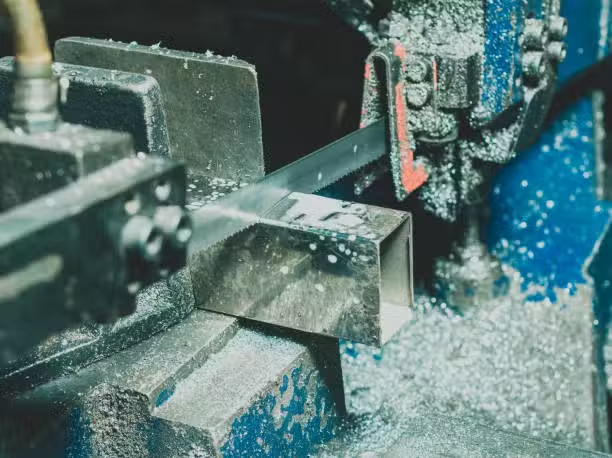
These are some of the advantages of EDM machining production:
Complex Shapes
Electrical Discharge Machining (EDM) excels at machining complex and intricate shapes that would be challenging or impractical to produce using conventional machining methods. It achieves this by using electrical discharges (sparks) to erode material from the workpiece. This process is highly controllable and can create intricate contours, sharp corners, and fine details. This capability is invaluable in industries like aerospace, automotive, and medical, where components often have intricate and customized geometries. For instance, turbine blades in aerospace engines often have complex airfoil shapes, efficiently and precisely machined using EDM.
Hard Materials
EDM is exceptionally effective in machining hard materials such as tool steels, carbides, and exotic alloys that are difficult to work with using traditional methods. The process uses thermal energy from electrical discharges to erode the material, and it is not dependent on the hardness of the workpiece. This makes it suitable for even the toughest materials. EDM enables the production of tools, dies, and components with high hardness and wear resistance, ensuring they can withstand the rigors of industrial applications. For example, injection molds for plastic molding processes are often made from hardened steels, and EDM is a preferred method for creating these molds.
Precision
EDM is renowned for its ability to achieve exceptionally high levels of precision, often down to micron-level tolerances. It operates with a high degree of control over the material removal process, allowing for tight dimensional accuracy and surface finish. This precision is crucial in industries like aerospace, medical, and electronics, where components must meet strict specifications for functionality and safety. For instance, EDM is used to produce intricate surgical instruments, where precision is paramount for their effectiveness in medical procedures.
Small Batches
EDM is well-suited for small batch production runs, making it ideal for rapid prototyping and customized or specialized components. It does not require specific tooling, making it adaptable to produce small quantities without expensive setup changes. This flexibility is advantageous in industries like aerospace, automotive, and jewelry, where small production runs or prototypes are common. In the jewelry industry, where each piece may be unique, EDM allows for efficiently producing custom-designed items in small quantities.
EDM Design Considerations
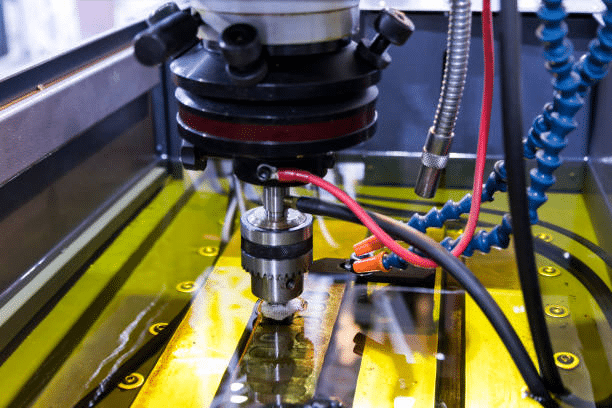
These are some of the things you need to consider before going for EDM designs:
Part Material
The choice of material is crucial for EDM. Conductive materials like metals are ideal, as EDM relies on electrical discharges. Hard materials, such as carbides, and tool steels, are well-suited for EDM. The hardness of the material directly affects the efficiency of material removal, making it a critical consideration.
Surface Finish
Determining the desired surface finish is important. The desired surface finish influences the choice of electrode material and shape. Additionally, consideration must be given to any post-EDM polishing or finishing operations required to achieve the desired level of smoothness and texture.
Tolerances
Tolerance specifications define allowable variation from nominal dimensions. EDM can achieve highly tight tolerances, often in the micron range. When designing for EDM, it’s essential to specify tolerances based on the requirements of the application and the capabilities of the EDM machine. Additionally, designers must account for electrode wear, which can affect final dimensions.
Proper Clamping
Securing the workpiece is crucial for accurate EDM operations. Effective clamping ensures the workpiece remains stable and securely positioned throughout the EDM process. This prevents any movement or vibration that could lead to inaccuracies. Improper clamping can lead to deflection of the workpiece, causing the electrode to overcut, resulting in dimensional inaccuracies.
Programming and CAD/CAM
Accurate programming is essential for successful EDM operations. CAD/CAM software is used to generate toolpaths that guide the movement of the electrode. These toolpaths must be meticulously designed to achieve the desired part geometry. Additionally, programming involves setting parameters like pulse duration, spark gap, and flushing rate. These settings need to be optimized for the specific material and geometry being machined.
Postprocessors
Postprocessors are essential in converting toolpath data into instructions that the EDM machine can execute. The choice of postprocessor must be compatible with the specific EDM machine being used to ensure that the generated toolpaths can be accurately executed. Additionally, postprocessors can be customized to optimize toolpaths for factors like minimizing electrode wear, maximizing material removal rates, and achieving precise geometries.
Choosing a Wire EDM

There are some things you need to know before choosing a wire EDM to ensure you get the best rapid prototype products. Some of these include:
Machining Capacity
The machining capacity of a Wire EDM machine refers to its ability to handle workpieces of specific sizes and weights. This includes considerations for both the physical dimensions of the workpiece and the maximum thickness it can effectively cut through. Understanding the machining capacity is crucial to ensure that the chosen Wire EDM machine can handle the size and thickness of the workpieces intended for production. This prevents the need for multiple setups or the risk of being unable to process larger or thicker materials.
Automation Levels
Automation levels in a Wire EDM machine refer to the degree to which it can operate independently. This includes tasks like tool changing, workpiece handling, and toolpath adjustments. Higher levels of automation can significantly increase the machine’s efficiency by reducing manual intervention and setup times. Machines with higher automation levels may require less skilled operators, impacting training requirements and labor costs.
Accuracy
Accuracy in Wire EDM refers to how closely the actual machined dimensions match the intended design. This encompasses factors such as positional accuracy, straightness, and corner radii. High accuracy is crucial for industries where tight tolerances are non-negotiable, such as aerospace, medical, and precision engineering. Accurate machining minimizes the likelihood of producing defective parts, which can save time and materials.
Profitability
Profitability considerations for a Wire EDM machine encompass various factors related to its overall cost-effectiveness. This includes the initial investment, operational costs, and potential returns on investment (ROI). Evaluating the total cost of ownership, which provides for the purchase price, maintenance costs, and operating expenses, helps select a machine that offers a favorable balance of cost and benefits. Understanding the potential returns on investment, including increased production capacity or capabilities, can guide decisions on machine selection.
Take advantage of Zintilon for Your Wire EDM Services.
Wire EDM is a cutting-edge manufacturing technique known for its unrivaled precision and ability to create intricate designs. While its capabilities are extensive, its success is frequently dependent on the expertise of the service provider. Here comes Zintilon. Our dedication to this craft ensures that every project benefits from CNC machining industry knowledge and cutting-edge machinery.
For those looking to realize the full potential of Wire EDM service, working with a dedicated expert like Zintilon guarantees not only flawless results but also a smooth and efficient journey from concept to completion. Dive deep into the world of precision with Wire EDM and realize the full potential of your project!
FAQs
Why Is Deionized Water Used in Wire Cut EDM?
Deionized water is the dielectric medium employed in wire EDM because of its low carbon content. It acts as a coolant to control the temperature of the dielectric.
What’s the Difference Between Laser Cutting and Wire EDM?
While wire erosion die cutting (EDM) uses electrical erosion from a wire, laser cutting uses a powerful thermal beam to cut materials.
What Are the Other Types of EDM Available?
In addition to wire EDM, there is hole drilling EDM and sinker EDM. The electrode used makes the difference. The electrodes in hole EDM are tubular, resulting in smaller and deeper holes. Sinker EDM, on the other hand, uses an electrically conductive metal to create a replica of the desired shape.
Read More
- Wire EDM Cutting: Process, Applications, and Advantages – Zintilon
- What Is Anodized Aluminum? Complete Overview of the Process – Zintilon
- ZINTILON Quality Control Equipment List – Zintilon
- How to Distinguish Brass, Bronze and Copper?-Differences Between Brass, Bronze and Copper – Zintilon
- Understanding CNC Machining: A Guide to Common CNC Machine Types and Their Uses – Zintilon



